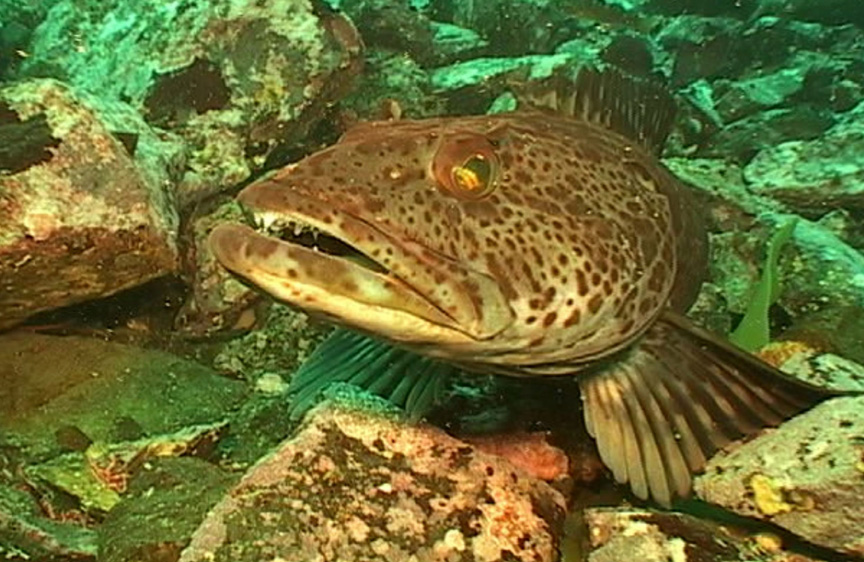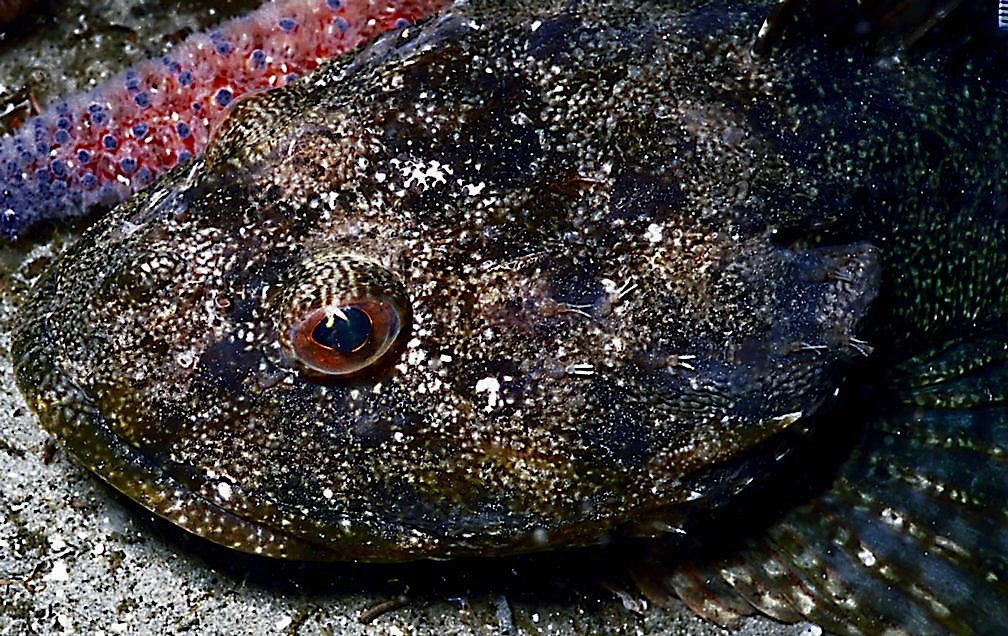
LIFE HISTORY:
Spawning takes place from December to March .Females deposit their eggs in a mass under the rocks in shallow water .The eggs vary around 3.5 millimeters in diameter when water hardened and have a tough membranous shell.The newly hatched young are 7 to 10 millimeters long and have blue eyes.The yolk sac is absorbed in about 10 days .After a few weeks growth, the young fish are attracted to lights at night .Females reach 1 meter at 10 to 14 years .Male seldom exceed 1 meter in 12 years.Newly maturing females produces (60,000)100,000 to 150,000 eggs. Large females may produce as many as 500,000 eggs.
HART, J.L, Pacific Fishes of Canada, FISHERIES RESEARCH BOARD OF CANADA. Ottawa, 1973
IMPORTANT NOTES:
-Lingcod have been over fished in British Columbia to the extent that there is now a closure on the fishing .They have been protected at Race Rocks since the fishing closure in 1990 .Divers see them frequently in water 6 to 12 meters depth.Their eggs masses appear on vertical rock walls in protected niches the adult fish patrols and defends the egg mass from predators. It will attack divers during incubation period in January and February.
LING COD CONSERVATION
Report from the Vancouver Aquarium on Link Cod Egg mass surveys. http://www.vanaqua.org/lingcodsurvey/
From DFO press July, 2002: “Lingcod Conservation Measures Strengthened”
VANCOUVER, BRITISH COLUMBIA–Fisheries and Oceans Canada announced today the expansion of management measures in the recreational fishery for the protection of lingcod in the Strait of Georgia.
A 2001 Pacific Scientific Advice Review Committee (PSARC) report on lingcod confirmed that, despite a variety of conservation measures in recent years, lingcod stocks in the Strait of Georgia remain at low levels. Fisheries and Oceans Canada had delayed opening the Strait of Georgia recreational lingcod fishery pending further analysis of the PSARC information and review of additional material received from the recreational community.
After careful consideration of all the information, the Department has decided to maintain the recreational closure for lingcod fishing in the Strait of Georgia (Areas 13 to 19, and Areas 28 and 29). If a lingcod is incidentally caught in these Areas, it should then be immediately released back into the water. The recreational lingcod fishery will continue in the North Coast and on the West Coast of Vancouver Island. Harvest by First Nations for food, social and ceremonial purposes will continue in the Strait of Georgia. The impact of this fishery is small.
Since 1990, the commercial lingcod fishery in the Strait of Georgia has been closed. In the recreational fishery, management measures have included an eight month winter closure (October to May) to protect nest guarding males, a size limit restriction (to allow a fish to reproduce prior to harvest), and daily and annual catch limits. However, until a sustained improvement is noted for these stocks of concern, the Department feels that additional measures are required.
Like rockfish, lingcod are believed to be fairly sedentary, livingmost of their lives in the same rocky area or subtidal reef. However, unlike rockfish, the mortality of lingcod in catch-and-release fisheries is low (less than 10 per cent).
As an important component of both the recreational and commercial groundfish fisheries, lingcod are also expected to benefit from the inshore rockfish conservation strategy that is being developedand implemented. Inshore rockfish conservation measures, such as fishing restrictions in selected areas on the coast, will assist with protecting and rebuilding both inshore rockfish and lingcod stocks. In addition, a stock assessment framework for lingcod will be developed, which will further our understanding of lingcod and their distribution.
Fisheries and Oceans Canada has made a commitment to ensure the sustainability of British Columbia’s inshore rockfish and lingcod fisheries for the benefit of Canadians today and in the future. With the cooperation of all harvesters, lingcod and inshore rockfish stocks can be protected and rebuilt.
FOR FURTHER INFORMATION CONTACT:
Fisheries and Oceans Canada, Pacific Region
FISH BASE reference
| Dec-2002- |
Fariba Hussaini, (PC yr 29) |
CLASSIFICATION
Domain Eukarya
Kingdom Animalia
Phylum Chordata
Class Actinopterigii
Order Scorpaeniformes
Family Hexagrammidae
Subfamily Ophiodontinae
Genus Ophiodon
Species elongatus
Common Name: Lingcod
 The Race Rocks taxonomy is a collaborative venture originally started with the Biology and Environmental Systems students of Lester Pearson College UWC. It now also has contributions added by Faculty, Staff, Volunteers and Observers on the remote control webcams. Garry Fletcher
The Race Rocks taxonomy is a collaborative venture originally started with the Biology and Environmental Systems students of Lester Pearson College UWC. It now also has contributions added by Faculty, Staff, Volunteers and Observers on the remote control webcams. Garry Fletcher

